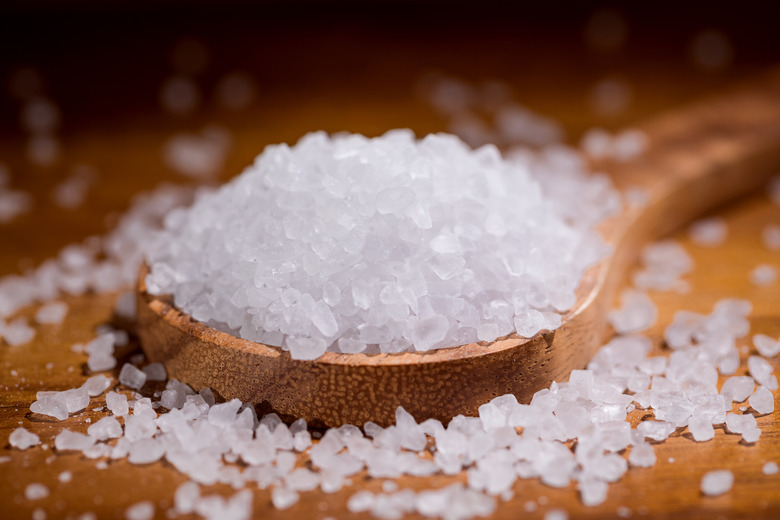How Many Valence Electrons Does Sodium Have?
Valence electrons occupy the outermost electron shell in an atom. Sodium, with a total of 11 electrons, has only one electron in its third and outermost shell. Because the outermost shell comes into direct contact with other atoms when a chemical reaction takes place, the valence electrons play a big role in determining the chemical reactivity of an element and the elements with which it will react to form compounds. Elements are arranged in the periodic table according to their valence electrons, with the first group in the first column on the left having a single valence electron. Sodium is the third from the top in this group.
TL;DR (Too Long; Didn't Read)
Sodium has one valence electron. The element has a full innermost electron shell of two electrons and a full shell of eight electrons in the next shell. The third shell, which is the outermost and the valence shell, has only one electron. Valence electrons influence chemical reactivity.
How Valence Electrons Influence Chemical Reactions
How Valence Electrons Influence Chemical Reactions
The electrons around the nucleus of an atom form shells. The innermost electron shell has room for two electrons while the next shell can accommodate eight electrons. The third shell has three subshells of two, six and 10 electrons for a total of 18.
The chemical stability of an atom is greatest when all its electron shells are full, but its chemical reactivity is highest when the outermost shell either has only one electron or is one electron short of being full. In these cases, a single electron is transferred, meaning the outermost shell of the donating or receiving atom is complete. The transfer of the electron results in a chemical bond and the formation of a compound.
How Sodium Reacts With Other Elements to Form Compounds
How Sodium Reacts With Other Elements to Form Compounds
Sodium, with its single outermost electron, reacts strongly and forms highly stable compounds with elements that need a single electron to complete their outermost shell. When a sodium atom comes in contact with an atom that needs a single electron, the valence electron from the sodium atom jumps over to the other atom to complete its outermost electron shell. The sodium atom is left with a full outermost electron shell with eight electrons, and the outermost shell of the other atom is full as well. The sodium atom now has a positive electrical charge of plus 1, and the other atom has a negative charge of minus 1. The two opposite charges attract, and the two atoms now form the molecule of a compound.
While the elements with one valence electron are located on the left of the periodic table, the elements that need one valence electron to complete their outermost shells are found in the second to last column. For example, in the same row as sodium, the element in the next-to-last column is chlorine. Chlorine has 17 electrons, two in its innermost shell, eight in the next shell and seven in the third subshells that hold up to eight electrons. Sodium and chlorine react strongly to form sodium chloride or table salt, a stable compound.
The Valence Electrons of Sodium Ions in Solution
The Valence Electrons of Sodium Ions in Solution
When a compound dissolves in a liquid, the compound separates into ions that distribute themselves evenly throughout the liquid. Sodium chloride dissolves in water and forms sodium and chlorine ions. When the sodium reacted with the chlorine to form sodium chloride, the single sodium valence electron jumped over to fill the hole in chlorine's valence electron shell.
In solution, the sodium and chlorine atoms separate to form sodium and chlorine ions, but the sodium valence electron stays with the chlorine atom. As a result, the sodium ion has a complete outermost electron shell of eight electrons and a positive charge of plus 1. The chlorine ion has a complete outermost electron subshell and a negative charge of minus 1. The solution is stable, the ions with their complete outer shells not engaging in any further chemical reactions.
Cite This Article
MLA
Markgraf, Bert. "How Many Valence Electrons Does Sodium Have?" sciencing.com, https://www.sciencing.com/how-many-valence-electrons-does-sodium-have-13710213/. 14 March 2018.
APA
Markgraf, Bert. (2018, March 14). How Many Valence Electrons Does Sodium Have?. sciencing.com. Retrieved from https://www.sciencing.com/how-many-valence-electrons-does-sodium-have-13710213/
Chicago
Markgraf, Bert. How Many Valence Electrons Does Sodium Have? last modified March 24, 2022. https://www.sciencing.com/how-many-valence-electrons-does-sodium-have-13710213/
